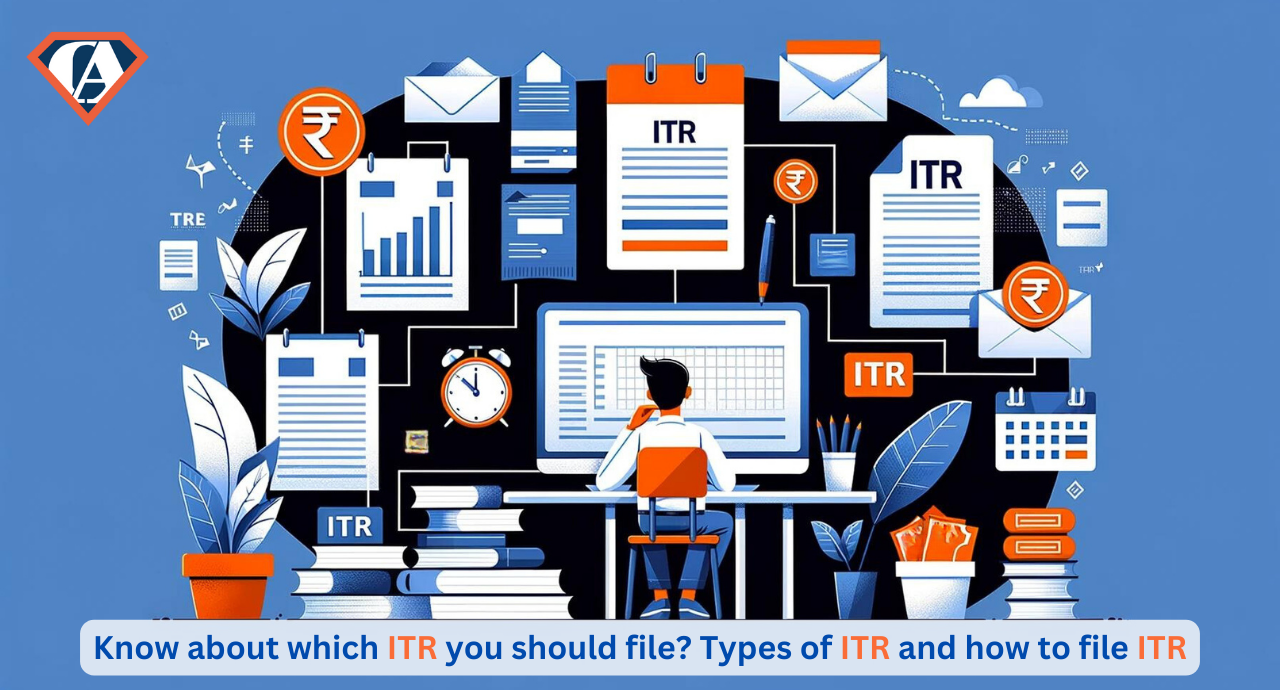ITR - Know about Which ITR You Should File? Types of ITR and how to File ITR
- Posted By SuperCA
- On 09 March

Introduction
Filing Income Tax Returns (ITR) is a fundamental duty of every taxpayer in India. It not only contributes to the nation's development but also provides an official record of an individual's income and tax payments. This blog aims to demystify the process of determining which ITR form suits your needs, the different types of ITR forms available, and how to file your ITR correctly and efficiently.
Understanding Different Types of ITR Forms
The Income Tax Department has designated various ITR forms for different types of taxpayers based on their income sources, amount of income, and category:
- ITR-1 (Sahaj): For individuals earning income from salaries, one house property, other sources (interest, etc.), and having a total income up to Rs. 50 lakh.
- ITR-2: For individuals and HUFs not having income from profits and gains of business or profession.
- ITR-3: For individuals and HUFs having income from profits and gains of business or profession.
- ITR-4 (Sugam): For presumptive income from business & profession.
- ITR-5: For persons other than individual, HUF, company, and person filing ITR-7.
- ITR-6: For Companies other than companies claiming exemption under section 11.
- ITR-7: For persons including companies required to furnish return under sections 139(4A), 139(4B), 139(4C), and 139(4D).
Each form caters to a specific taxpayer category, making it crucial to understand which form aligns with your income structure.
Determining Which ITR to File
Selecting the right ITR form is critical for compliance with tax regulations. Here's how to determine which form you should file:
- Assess Your Sources of Income: Different ITR forms are applicable based on whether you earn salary income, business income, rental income, or other sources.
- Consider Your Total Income: Some forms are designed for individuals with income below a certain threshold.
- Review Special Circumstances: Owning assets outside India, having foreign income, or wanting to carry forward losses affects your choice of ITR form.
Understanding these factors will guide you in selecting the appropriate ITR form for your situation.
Step-by-Step Guide to Filing ITR
Filing ITR online, also known as e-filing, is a straightforward process:
- Register/Login on the e-Filing Portal: Visit the Income Tax e-Filing portal and log in or register if you're a new user.
- Choose the Appropriate ITR Form: Based on your income assessment, select the right ITR form.
- Fill in the Required Details: Enter your personal information, income details, deductions, and taxes paid.
- Verify Your Return: You can verify your return electronically using Aadhaar OTP, EVC through your bank account, or by sending a signed ITR-V to the CPC, Bangalore.
- Submit Your ITR: After verification, submit your ITR. You'll receive an acknowledgment from the IT Department.
Documents Required for Filing ITR
To file your ITR smoothly, keep the following documents ready:
- PAN Card
- Aadhaar Card
- Bank account details
- Form 16 (if employed)
- Interest statements from banks/post offices
- Proof of investments for deductions
- TDS certificates, if applicable
Having these documents at hand will make the ITR filing process more efficient.
Common Mistakes to Avoid While Filing ITR
Ensure a hassle-free filing experience by avoiding these common mistakes:
- Incorrect Personal Details: Always double-check your PAN, Aadhaar, and bank account details.
- Choosing the Wrong ITR Form: Selecting the incorrect form can lead to your return being deemed defective.
- Underreporting Income: Ensure all income sources, including interest income, are fully reported.
- Not Claiming Deductions: Maximize your tax savings by claiming all eligible deductions.
- Ignoring Previous Years' Tax Returns: Ensure all previous years' returns are filed to avoid penalties.
Conclusion
Understanding which ITR form to file, preparing the necessary documents, and following the step-by-step guide to e-filing can simplify the tax filing process. By being mindful of common mistakes and ensuring accurate and complete information, taxpayers can fulfill their obligations with confidence and ease.
This comprehensive guide aims to equip you with the knowledge needed to navigate the ITR filing process, reinforcing the importance of timely and accurate tax compliance.
Frequently Asked Questions (FAQs) About Filing ITR
Q1: Can I file ITR if I have no income?
A1: Yes, you can file a nil return if you have no income. Filing a nil return can be beneficial for maintaining a continuous financial record, especially if you plan to apply for loans or visas in the future.
Q2: How do I know if I have chosen the wrong ITR form?
A2: If you select an incorrect ITR form, the Income Tax Department may notify you of a defective return, and you will be given an opportunity to rectify the error by filing a revised return with the correct form.
Q3: What is the deadline for filing ITR?
A3: The deadline for filing ITR varies each assessment year but is typically July 31st for individuals. However, it is subject to extension by the IT Department, so always check the latest notifications.
Q4: Can I file ITR after the deadline?
A4: Yes, you can file a belated ITR until December 31st of the assessment year, but it may attract a late filing fee.
Q5: What are the consequences of not filing ITR?
A5: Not filing ITR can result in penalties, interest on taxes due, and you may also miss out on carrying forward certain losses to future years.
Q6: How can I verify my ITR?
A6: ITR can be verified electronically via Aadhaar OTP, EVC through your bank account, or by sending a signed physical copy of ITR-V to the Central Processing Centre in Bangalore within 120 days of filing.
Q7: What should I do if I make a mistake in my filed ITR?
A7: If you discover a mistake after filing your ITR, you can file a revised return correcting the errors. The revised return can be filed any time before the end of the relevant assessment year or before the completion of the assessment, whichever is earlier.





